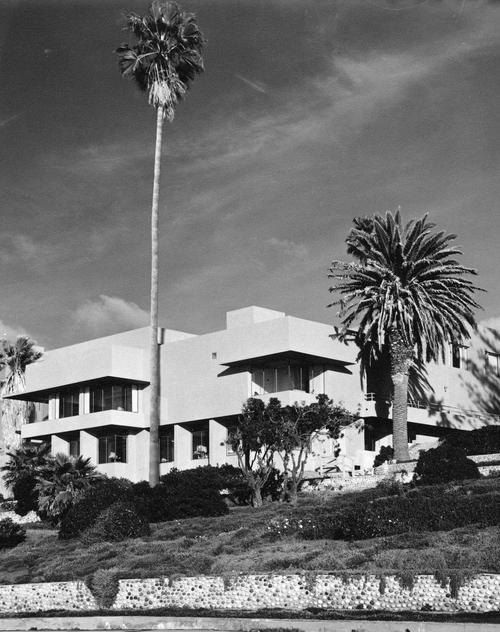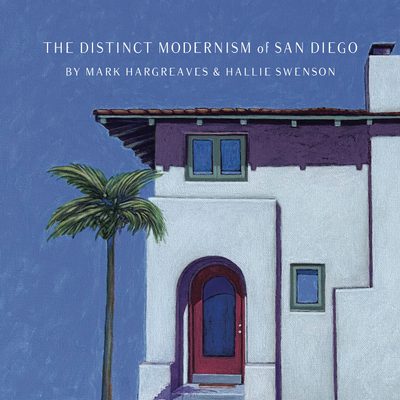Art
Mid-Century Modern La Jolla

Following World War II, La Jollans were exposed to modern art, contemporary craft, as well as progressive designs in furniture, graphic design and architecture at the peak of the modern movement’s reach into the west coast psyche.
By Keith York

Following World War II, La Jollans were exposed to modern art, contemporary craft, as well as progressive designs in furniture, graphic design and architecture at the peak of the modern movement’s reach into the west coast psyche. How La Jollans engaged in this, often tense, dialogue between ‘conservative’ and ‘contemporary’ is worthy of further study.
In considering the impact 20th Century modernism had on La Jolla, it helps to have works by pioneering modernist architects Irving Gill and Rudolf Schindler in the zip code. While Gill’s and Schindler’s work was arguably ahead of its time in North America, the Post-War boom of the region and unique culture of modernism in architecture and the arts, impacted the look, feel and growth of La Jolla from the 1940s through the 1960s.
Works in La Jolla by Louis Kahn (Salk Institute), A. Quincy Jones (Mandeville Center for the Arts), Richard Neutra (Oxley Residence), Robert E. Alexander (early buildings at UC San Diego), William Pereira (General Atomics) and Edward Durrell Stone (Scripps Green Hospital) will certainly draw the interest of authors and historians to consider the impact of modern architecture on the region.
But equally important was the concentration of smart young artists and architects trained elsewhere who relocated to La Jolla, a beautiful small town on the fringe of significant growth and change.
In the village, offices of architects Henry Hester & Robert E. Jones, Sim Bruce Richards, Frederick Liebhardt & Gene Weston, Dale Naegle, Russell Forester, as well as Robert Mosher & Roy Drew provided La Jollans, and the region at large, a generous supply of modernist ideas. This unique cluster of colleagues and friends helped La Jolla’s built environment mature – and were often key advocates for integrating modern art and design with architecture.
The unique blend of competition and camaraderie among La Jolla’s modernists was likely related to their wildly different approaches to design. Sim Bruce Richards and Frederick Liebhardt, both trained with Frank Lloyd Wright, brought an ‘organic’ approach to their early work -- more so than the stark rectilinear ideas of Russell Forester, who more closely followed Mies Van Der Rohe than the regional force that was the Los Angeles Times Home Magazine. USC’s School of Architecture, which had a profound impact on Southern California’s built environment after the War, produced a number of talented hands that moved south including Henry Hester, Dale Naegle and Robert Jones. The partnership between Robert Mosher and Roy Drew would bring the entire spectrum of modernism to their projects – from the woodsy, Japanese inspiration found in the Green Dragon Colony buildings of 1949 to International Style work of the 1950s (Art Center in La Jolla 1950 remodel) and what later would be labeled Brutalism (Applied Physics & Math building at UC San Diego).
One must consider that modern architecture was not the prevalent style in Post-War La Jolla. Natives and recent émigrés found much of contemporary architecture to be cold, radical and well out of the mainstream. Modern art was still unfamiliar and threatening. Unique to La Jolla was strong ties among artists and architects - strongly linked and part of the same, often misunderstood or unappreciated subculture. Clients of Russell Forester and Sim Bruce Richards invested in the integration of art and architecture into a ‘whole’. Richards’ office also served as an art gallery. Russell Forester placed his own art, and that of his contemporaries, into the homes he designed for clients like Lynn & Danah Fayman.
Arguably a more conservative community than Los Angeles, Chicago or New York City, La Jolla did not fully embrace ‘modern art’ in the post-war years despite venues like the Jefferson Gallery, artists and designers like Russell Forester and Gil Watrous, as well as boosters like the Art Center in La Jolla.
While major art world developments such as abstract expressionism were still unfamiliar to most San Diegans in the late 1950s, the Art Center in La Jolla (now the Museum of Contemporary Art San Diego) played a significant role in the acceptance of new modes of painting and sculpture in the area. Contemporary photographer Lynn Fayman served as president of the board, artist and architect Russell Forester chaired the exhibitions committee, the Art Center's director Donald Brewer was an abstract painter and so was the assistant director, Don Dudley. With a staff that was dominated by progressive artists, the Art Center established the experimental La Jolla School of Arts and Crafts in January, 1960. The school lasted only four years but attracted artists from far and wide as students, educators and artists-in-residence. Faculty members including Fred Holle, Sheldon Kirby, Guy Williams, Beatrice Levy, Rhoda Lopez and Malcolm McClain were brought together at the Art Center during a dynamic time in its development as an institution devoted to contemporary art.
Architects William Krisel, Herbert Brownell and Edward Fickett’s designs of nearby housing tracts proved more affordable than the custom homes of well-heeled La Jollans nearby. Tract housing designed by these skilled modernists exploited the climate’s ability to realize the indoor-outdoor living aesthetic – structurally employing lanais, patios, floor-to-ceiling glass, outdoor dining areas and walls of glass framing views of the ocean to the west and the Laguna mountains to the east – all on a budget.
Retail stores like Armin Richter and Associates, Viejas La Jolla, and Dean Marshall Interiors provided La Jollans with access to regional arts & crafts, European furniture and textiles as well as staple modernist furniture produced by Herman Miller, Knoll and Glenn of California among others. If you needed a hand arranging the pieces you just bought, then interior decorators Dean Marshall, Gerald Jerome or Armin Richter were on hand to help you.
Today, we see remnants here and there that suggest a fascinating and innovative period of time in local art and architecture. More work is needed in helping us rediscover the recent past and magnify the unique history, the role of modernism, and those La Jollans that served as its fans and detractors – the tensions between which define ‘Modern La Jolla’ as unique and worthy of further study.
Have an idea or tip?
We want to hear from you!
email hidden; JavaScript is required

Architecture
Modern San Diego Stuff For Sale

Architecture
Streamline Modern(e) San Diego

Architecture